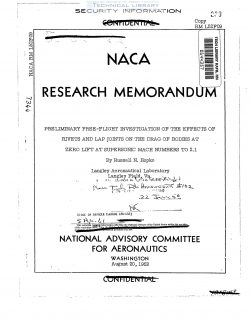naca-rm-l52f09
- Version
- 60 Downloads
- 374.08 KB File Size
- 1 File Count
- May 31, 2017 Create Date
- May 31, 2017 Last Updated
National Advisory Committee for Aeronautics, Research Memorandum - Preliminary Free Flight Investigation of the Effects of Rivets and Lap Joints on the Drag of Bodies at Zero Lift at Supersonic Mach Numbers to 2.1

The effects of rivets and lap joints on the drag of bodies at zero
lift at supersonic Mach numbers to 2.1 have been obtained in free flight
with rocket—propelled models. Four forward—facing lap joints 0.06% inch
high, four similar lap Joints facing rearward, and four double rows of
inch—diameter brazier head rivets were tested on a 5-inch—diameter
body 56 inches long. The brazier head rivets caused the smallest drag
increases while the lap joints facing forward caused the largest drag
increases. At a Mach number of 2.0 the increases in drag coefficient
due to the rivets and lap joints ranged from 20 to 80 percent of the
estimated smooth—body skin-friction drag coefficient.
At the present time there are little data on the additional body
drag produced by surface—roughness elements at supersonic Mach numbers
and large Reynolds numbers. A research program has been initiated by
the Pilotless Aircraft Research Division to ascertain, experimentally,
the effects of some surface irregularities on the drag of bodies at zero
lift at supersonic speeds. In the investigation reported in reference 1,
the effects on drag of over—all surface conditions consisting of small
protuberances and depressions were obtained. The results indicated that
the protuberances produced substantial drag increases but that some sur-
face roughness produced by depressions did not increase the drag. The
present investigation is concerned with the drag penalties arising from
surface-roughness conditions resulting from practical manufacturing
procedures. In this paper, results are presented for forward- and
backward—facing lap joints and for protruding rivet heads.
The Mach number range was from 0.9 to approximately 2.1. The
corresponding range in Reynolds number, based on body length, was from
20 x 106 to 60 x 106.
The flight tests were conducted at the Pilotless Aircraft Research
Station, Wallops Island, Va. The results are presented without complete
analysis in order to expedite publication and because the investigation
is still in the exploratory stages.
| File | Action |
|---|---|
| naca-rm-l52f09 Preliminary Free Flight Investigation of the Effects of Rivets and Lap Joints on the Drag of Bodies at Zero Lift at Supersonic Mach Numbers to 2.1.pdf | Download |
Comment On This Post